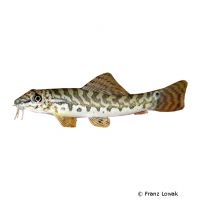Banded Mountain Loach (Acanthocobitis urophthalmus)
| Banded Mountain Loach Acanthocobitis urophthalmus | |
|---|---|
| Name | Banded Mountain Loach |
| Name Lat. | Acanthocobitis urophthalmus |
| Synonym | Paracanthocobitis urophthalma |
| Family | Stone Loaches |
| Family lat. | Nemacheilidae |
| Order | Carps |
| Order lat. | Cypriniformes |
| Origin | Sri Lanka |
| Habitat | Streams |
| Diet | Omnivore |
| pH | 6.0-7.5 |
| Behavior | Semi-aggressive |
| Keeping | Group |
| Care Level | Moderate |
| Reproduction | Egg scatterer |
| Breeding | None reported |
| Life Span | 4-7 years |
| Protection | No |
| Metric Units | |
| Size | 4 cm |
| Temperature | 20-25 °C |
| Hardness | < 12 °dH |
| Aquarium | ~ 80 l |
| US Units | |
| Size | 1.6" |
| Temperature | 68-77 °F |
| Hardness | < 214 ppm |
| Aquarium | ~ 20 gal |
Distribution and habitat
Eye spot loaches are found exclusively in the western lowlands, between the Kelani and Nilwala Rivers in Sri Lanka. They live in moderately flowing streams and rivers, with dense vegetation and sandy bottoms, among roots, stones and foliage. They prefer shallow places close to the banks, shaded by trees and bushes.
Maintenance
The aquarium should have dense planting, shady hiding places (roots, stones, caves), subdued light (floating plants), sufficient swimming space and a weak current. In order not to injure their barbels, a fine-grained substrate (sand, round gravel) is ideal, which can be covered with some foliage (e.g. sea almond leaves)
No ammonia, ammonium and nitrite should be detectable, the nitrate value should not exceed 100 mg/l. To ensure the water quality and oxygen content, a filter and heater adapted to the aquarium size is required, as well as lighting for the species-appropriate day-night rhythm of the animals.
Diet
They feed mainly on insects, small crustaceans and microplankton. The food supply consists of live, frozen and dry food. For a balanced diet, feed once daily with a high quality sinking dry food (granules, pellets, food tablets) as well as cyclops, daphnia, artemia, mosquito larvae and plankton (live or frozen). In addition, they also need some vegetable food, such as algae leaves or dry food with high vegetable content (e.g. kelp, spirulina).
Only feed as much as will be eaten within a few minutes. A regular and varied diet promotes health and increases resistance.
Behaviour and compatibility
They are peaceful and sociable fish, although territorial disputes may occasionally occur within the group. Socialization with not too small, robust fish is well possible. At least 5 eye spot loaches should be kept together. Individually kept animals remain skittish and shy. Basically, only compatible fish species with similar requirements to the water condition and water temperature may be socialized.
Sex dimorphism
There are no known external distinguishing characteristics.
Reproduction and breeding
There are no known reports of successful breeding in the aquarium.
Important
They are predominantly crepuscular and usually remain hidden in burrows or under rocks and roots during the day
The well-being of the fish should be checked regularly. The temperature should be checked daily, the pH, hardness and nitrate value at least every 14 days. Regular partial water changes are recommended, even if the pollutant load has not yet reached the upper limit. Sudden changes in water quality should be avoided. Newly introduced fish must be accustomed slowly to the water in the aquarium.
Further literature can be found in your pet store.
References
Text: petdata; Image: Franz Lowak
Source: BMELV (1998): Tierschutzgutachten - Haltung von Zierfischen (Süßwasser); BAENSCH & RIEHL (2004): Aquarien Atlas Bd. 2, Mergus Verlag; ENGELMANN (2005): Zootierhaltung - Tiere in menschlicher Obhut: Fische, Verlag Harri Deutsch
- Gemäß § 21 Abs. 5 Tierschutzgesetz idgF
